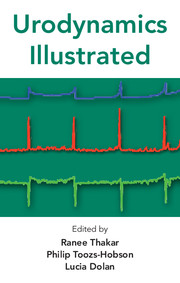Book contents
- Frontmatter
- Contents
- About the authors
- Acknowledgements
- Glossary and abbreviations
- Preface
- 1 Introduction
- 2 Setting up the equipment
- 3 Flow rate testing
- 4 Cystometry
- 5 Videocystourethrography
- 6 Ambulatory urodynamic monitoring
- 7 Urodynamic artefacts
- 8 Assessment of urethral function
- 9 Bladder diaries
- 10 Pad testing
- 11 Pre-test assessment using questionnaires
- 12 Ultrasound as a tool in urodynamics
- Index
7 - Urodynamic artefacts
Published online by Cambridge University Press: 05 February 2014
- Frontmatter
- Contents
- About the authors
- Acknowledgements
- Glossary and abbreviations
- Preface
- 1 Introduction
- 2 Setting up the equipment
- 3 Flow rate testing
- 4 Cystometry
- 5 Videocystourethrography
- 6 Ambulatory urodynamic monitoring
- 7 Urodynamic artefacts
- 8 Assessment of urethral function
- 9 Bladder diaries
- 10 Pad testing
- 11 Pre-test assessment using questionnaires
- 12 Ultrasound as a tool in urodynamics
- Index
Summary
Introduction
Data quality and documentation of variance are key for urodynamics studies to be valid and symptoms must be reproduced to be able to make a diagnosis. Accurate reporting requires knowledge of pathophysiological parameters and the ability to detect artefacts. If inaccuracies are discovered, they should be corrected contemporaneously.
Spurious and inaccurate observations are known as artefacts. These occur because of pitfalls including:
□ failure to reproduce symptoms
□ observations normally indicating pathology occurring in the absence of disease
□ biological variability leading to false negatives
□ the wide variation within the physiological range of the normal population.
Factors affecting urodynamic investigations
Several factors may influence the measurements recorded on the cystometrogram:
□ filling medium type, temperature and rate of infusion
□ catheter size
□ patient position
□ artificial environment
□ communication
□ inaccuracies in uroflowmetry
□ equipment (all equipment should conform to International Continence Society technical specifications)
□ voided volumes less than 150–200ml.
Uroflowmetry artefacts
Artefacts during uroflowmetry may arise owing to several factors, which can be broadly classified into two groups: extracorporeal and intracorporeal.
Extracorporeal causes include:
□ flow interference between the collecting funnel and flowmeter
□ movement of the stream across the funnel surface
□ patient movement (Figure 7.1).
Intracorporeal causes include:
□ rapid abdominal straining (Figure 7.2)
□ fast and rapid flow (Figure 7.3).
Recommendations to minimise uroflowmetry artefacts include ensuring privacy, checking the report and tracing immediately, correcting artefacts manually and checking that the void was representative of normal.
Keywords
- Type
- Chapter
- Information
- Urodynamics Illustrated , pp. 81 - 90Publisher: Cambridge University PressPrint publication year: 2011



